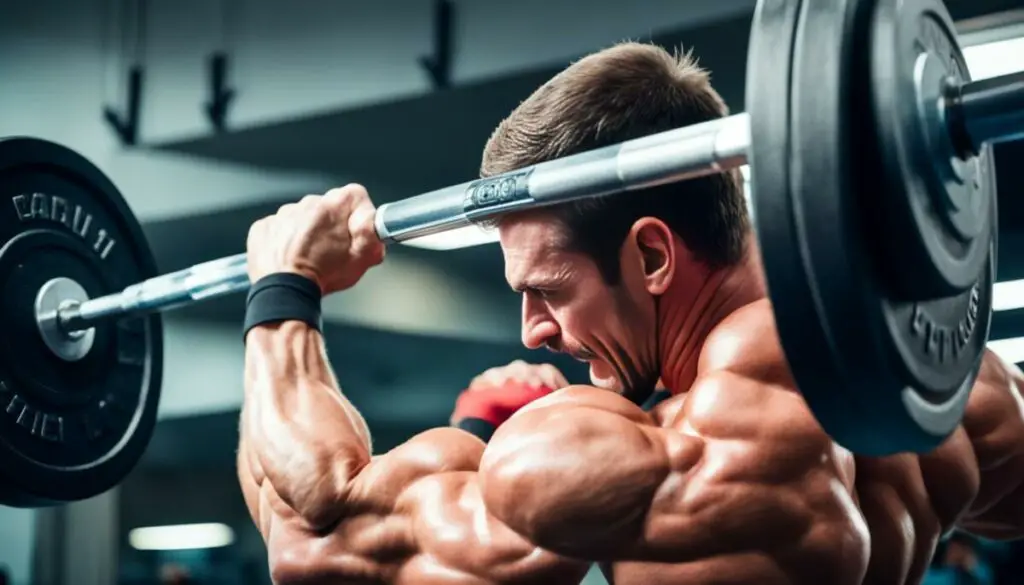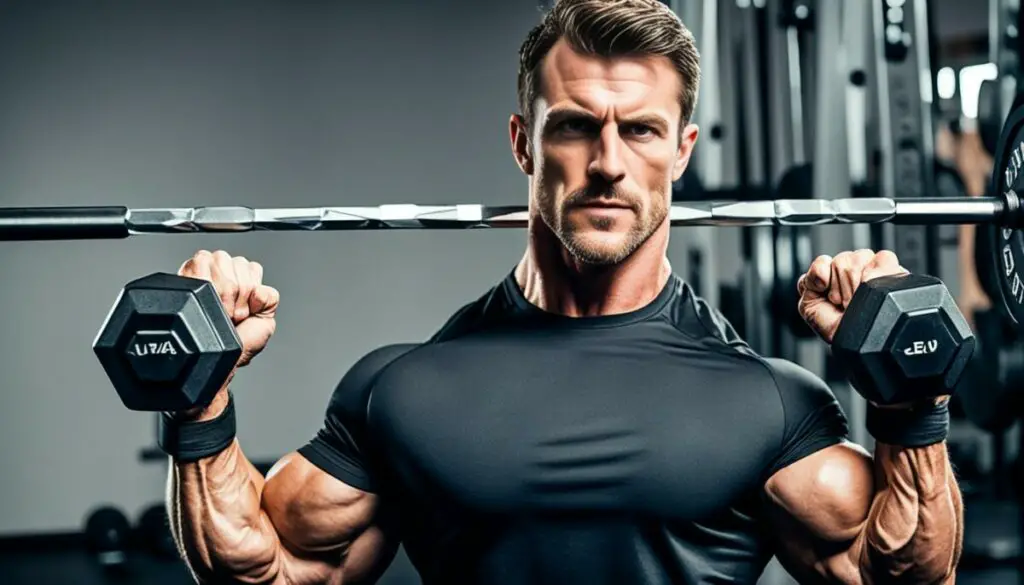Last Updated on 3 months by Francis
Looking to pump up your biceps and achieve those coveted gains? Look no further than cheating barbell curls. While they may have a controversial reputation, cheat curls are a highly effective technique for building massive biceps. By breaking the rules of strict form and incorporating cheat reps into your barbell curl routine, you can recruit more muscle fibers, increase tension, and trigger substantial muscle growth.
Contents
Key Takeaways:
- Cheating barbell curls activate more muscle fibers, leading to greater contraction and muscular hypertrophy.
- Proper form and caution should be exercised when performing cheat curls, especially for inexperienced lifters.
- Cheating on bicep curls involves using momentum and other muscle groups to lift heavier weights.
- Metabolic stress induced by cheat curls can stimulate muscle growth, but it’s important to know your limits.
- Cheat curls should be part of a well-rounded biceps workout routine, not used as a substitute for strict curls.
How To Perform Cheat Curls Properly

Performing cheat curls with a barbell requires proper form and technique. To execute cheat curls correctly, follow these steps:
- Grip the barbell with an overhand grip at shoulder-width apart.
- Tilt your body forward slightly to engage your abs and stabilize your core.
- Pull the barbell backward with your upper body while curling it.
The aim is to find the perfect balance of momentum and muscle activation to effectively work the biceps. By using proper form, you can maximize the engagement of your biceps and target the muscle group more efficiently.
It’s important to note that cheat curls should be performed cautiously and only by experienced lifters who already have a good understanding of the proper form for the exercise they are attempting to build.
Remember, cheat curls should be used strategically as part of a comprehensive workout routine and not as a substitute for strict, controlled curls. Improper form and excessive momentum can lead to injury and compromise the effectiveness of the exercise. If you’re unsure about performing cheat curls, consult a fitness professional for guidance.
Proper Form for Cheat Curls
When performing cheat curls, it’s critical to maintain proper form to maximize the benefits and minimize the risk of injury. Here are some key pointers for maintaining proper form:
- Engage your biceps: Concentrate on contracting your biceps throughout the movement to ensure they are the primary muscles being targeted.
- Avoid excessive swinging: While some momentum is expected in cheat curls, excessive swinging of the barbell can put unnecessary strain on your joints and compromise the effectiveness of the exercise.
- Control the movement: Focus on both the concentric (lifting) and eccentric (lowering) phases of the curl. Slowly lower the barbell to fully engage your biceps and maintain control.
By following these guidelines, you can perform cheat curls safely and effectively, incorporating them into your biceps training routine for optimal results.
The Cheat Curl Technique in Action
Watch this video for a demonstration of the proper technique for cheat curls:
By observing and practicing the proper form, you can improve your cheat curl technique and reap the benefits of this advanced biceps exercise. Remember to start with lighter weights and gradually increase the load as you become more comfortable and proficient.
Benefits of Cheat Curls
Cheat curls, when performed correctly, offer several benefits that can enhance your biceps training:
| Benefit | Description |
|---|---|
| Increased muscle recruitment | By incorporating cheat curls into your routine, you can recruit additional muscle fibers, leading to greater muscle activation and growth in the biceps. |
| Greater bicep curl momentum | The use of controlled momentum in cheat curls allows you to lift heavier weights, increasing the overall intensity of the exercise and stimulating muscle hypertrophy. |
| Enhanced muscular contraction | Cheat curls enable a more forceful contraction of the biceps, resulting in a greater time-under-tension and an increased stimulus for muscle growth. |
By integrating cheat curls into your training routine, you can challenge your biceps in new ways, break through plateaus, and achieve greater strength and size gains.
Now that you know how to perform cheat curls properly, it’s time to put this technique into practice and make the most out of your biceps workouts. Remember to always prioritize safety and listen to your body to avoid overexertion or injury.
How To Use Cheat Curling Safely

When incorporating cheat curls into your workout routine, it’s crucial to prioritize safety to avoid injury and maximize the benefits. By following these safety tips, you can effectively control cheat curl movement and minimize the risk of accidents or muscle strain.
Avoiding Injury in Cheat Curls
1. Start with Proper Form: Before attempting cheat curls, ensure you have a solid foundation of strict curl technique. This will help you understand how to properly engage the target muscles and maintain control throughout the movement.
2. Gradually Increase Weight: It’s important to gradually increase the weight used in cheat curls to allow your muscles to adapt and strengthen over time. Avoid jumping to extremely heavy weights that may compromise your form and increase the risk of injury.
3. Focus on Muscle Failure: Muscle failure is a natural part of cheat curls, but it’s essential to know your limits. Pushing your muscles to the point of failure can increase metabolic stress, promoting muscle growth. However, be cautious not to overexert yourself and always listen to your body.
Controlling Cheat Curl Movement
1. Maintain Focus on Biceps: Although cheat curls involve recruiting other muscles for assistance, it’s essential to prioritize the biceps throughout the movement. Ensure that you’re feeling the contraction primarily in the biceps to effectively target the muscle group.
2. Prioritize Eccentric Control: Controlling the negative portion of the cheat curl, also known as the eccentric phase, can further enhance muscle activation and increase metabolic stress. Slowly lower the weight under control to maximize the benefits of the exercise.
“Proper control and technique during cheat curls can lead to increased muscle damage and growth.”
Muscle Failure and Metabolic Stress in Cheat Curls
1. Push Through Muscle Failure: When strict form fails during cheat curls, using momentum to continue the set can be an effective way to achieve muscle failure without compromising your progress. This technique allows you to fully push yourself and achieve maximum intensity.
2. Embrace Metabolic Stress: Cheat curls induce higher levels of metabolic stress, which can lead to increased muscle fiber recruitment and stimulate muscle growth. By embracing this stress and pushing your limits responsibly, you can optimize the benefits of cheat curls.
| Safety Tips for Cheat Curls | Avoiding Injury in Cheat Curls | Controlling Cheat Curl Movement | Muscle Failure and Metabolic Stress in Cheat Curls |
|---|---|---|---|
| Start with Proper Form | Gradually Increase Weight | Maintain Focus on Biceps | Push Through Muscle Failure |
| Prioritize Eccentric Control | Embrace Metabolic Stress |
By following these safety tips and techniques, you can safely incorporate cheat curls into your workout routine, effectively challenging your muscles and promoting growth. Remember to always prioritize proper form, gradually increase weight, and listen to your body to avoid accidents or overexertion.
What Are Cheat Curls?

Cheat curls involve breaking standard form and recruiting other muscles to assist in completing the exercise. The focus is on using eccentric lifting means, such as hyperextension of the arm or back, to hoist the weight being curled. This technique allows for heavier weights to be used and increases the load on the target muscle group.
Cheat curls can be beneficial for maximizing muscle tension and making the exercise more challenging, leading to muscle growth. By incorporating cheat curls into your workout routine, you can push your biceps to their limits and stimulate muscle hypertrophy.
However, it’s important to avoid cheating on cheat curls by using improper form or relying on excessive momentum. Maintaining control and engaging the targeted muscles throughout the movement is essential to ensure effective muscle recruitment and avoid potential injuries.
The Benefits of Cheat Curls
Performing cheat curls can offer several benefits for your bicep training:
- Maximized muscle tension: Cheat curls allow you to lift heavier weights and increase the load on your biceps, leading to greater muscle tension and potential growth.
- Enhanced challenge: By breaking standard form and recruiting additional muscles, cheat curls provide a more challenging exercise variation that can push you beyond your usual limits.
- Muscle recruitment: Cheat curls involve the activation of various muscle groups, such as the back and shoulders, in addition to the biceps. This can lead to increased muscle recruitment and overall strength gains.
By incorporating cheat curls into your training routine, you can add variety and intensity to your bicep workouts, potentially resulting in improved muscle growth and strength.
Proper Form in Cheat Curls
While cheat curls involve deviating from strict form, it’s important to maintain proper technique to ensure optimal results and reduce the risk of injury:
- Start with an appropriate weight that challenges your biceps but still allows you to maintain control and execute the movement effectively.
- Engage your core and maintain a stable posture throughout the exercise.
- Focus on controlling the eccentric (lowering) portion of the movement to maximize muscle tension and avoid relying solely on momentum.
- Avoid excessive swinging or jerking motions that can strain the muscles and joints.
By following these guidelines, you can perform cheat curls safely and effectively, capitalizing on their potential benefits for muscle growth and development.
Why Is Cheating OK?

Cheating is a controversial term in fitness and bodybuilding, often associated with taking shortcuts and undermining the principles of hard work and discipline. However, when done with intent and proper form, cheating can actually have its benefits. In the context of weightlifting and exercises like cheat curls, cheating refers to intentionally breaking standard form to recruit additional muscle groups and create more tension in the targeted muscles.
The main justification for cheating in fitness is that it can make the exercise more challenging and lead to greater muscle activation and growth. By deviating from strict form and using momentum or other muscles to lift heavier weights, cheat curls increase the tension on the biceps, resulting in greater muscle recruitment and stimulation of muscle hypertrophy. This extra tension can lead to muscle fibers being pushed to their limits and ultimately contribute to muscle growth.
During cheat curls, the tension in the muscles is increased due to the additional workload placed on them. The use of momentum and other muscle groups adds an element of dynamic movement, placing greater demands on the targeted muscles. This increased tension can trigger metabolic stress and greater muscle damage, which are two key factors in muscle growth.
Cheating on certain exercises can also be used strategically to break through plateaus and challenge the muscles in new ways. By introducing cheat curls into a workout routine, individuals can break the monotony of strict form exercises and stimulate further muscle development.
It’s important to note that cheating should be approached with caution and proper technique. Differentiating between intentional cheating with appropriate form and cheating as a way to make exercises easier is crucial. Cheating should not be used to substitute proper form and diligence in performing exercises, especially for competitive lifters.
Using cheating as a strategy to maximize muscle tension and growth can be effective when done mindfully and within the context of a well-rounded fitness routine.
Remember, the goal is to challenge the muscles and stimulate growth, not to compromise form or risk injury. So, embrace controlled cheating when appropriate, but always prioritize safety and consult with a fitness professional to ensure proper execution.
Key Takeaways:
- Cheating in fitness, when performed with intent and proper form, can have its benefits.
- By deviating from strict form and using momentum or other muscles, cheat curls create more tension in the targeted muscles.
- The justification for cheating in fitness is that it can make the exercise more challenging and lead to greater muscle activation and growth.
- Cheating strategically can break plateaus and stimulate further muscle development.
- Caution and proper technique are necessary when incorporating cheating into a fitness routine.
Biceps Bio
The biceps brachii, or biceps, is a two-headed muscle located in the arm. It plays a crucial role in arm movement, allowing for both arm flexion and forearm supination. The biceps consists of two heads – the longer head and the shorter head, each with its own origin point.
The longer head of the biceps originates from the supraglenoid tubercle on the scapula, while the shorter head is connected to the coracoid process. Together, these origin points provide stability and strength to the biceps.
One of the main functions of the biceps is arm flexion, which is the movement of bringing the forearm towards the upper arm. This action is commonly seen in exercises such as bicep curls.
Another important function of the biceps is forearm supination, which is the rotation of the forearm so that the palm faces upward. This movement is essential in various everyday activities, such as turning a doorknob or pouring a glass of water.
Cheat curls specifically target the biceps and aim to fully contract and activate the muscle. By incorporating cheat curls into a workout routine, individuals can effectively engage their biceps and stimulate muscle growth.
Biceps Function:
- Arm flexion
- Forearm supination
Biceps Origin Points:
- Longer head: Supraglenoid tubercle on the scapula
- Shorter head: Coracoid process
| Biceps Function | Biceps Origin Points |
|---|---|
| Arm flexion | Supraglenoid tubercle on the scapula |
| Forearm supination | Coracoid process |
Eccentricities
Cheat curls focus on eccentric contractions, where the muscle contracts while lengthening. These contractions are the most demanding type of muscle contraction and can generate more tension and stress on the muscle fibers. Unlike concentric contractions (muscle shortening), eccentric contractions occur when a muscle lengthens under tension, like during the lowering phase of a bicep curl.
During eccentric contractions, the muscle absorbs mechanical energy and converts it into elasticity or heat. This ability allows for greater muscle activation and workload on the biceps when performing cheat curls. By maximizing tension in the muscles and increasing the workload, cheat curls stimulate muscle growth and strength.
However, it’s important to note that eccentric contractions can also put muscles at a higher risk of injury. The force generated during an eccentric contraction can lead to muscle tear if the load is too heavy or if the movement is not controlled properly. Therefore, it’s crucial to use caution and gradually increase the weight and intensity of cheat curls to avoid muscle damage.
Types of Muscle Contractions
To better understand eccentric contractions, let’s take a look at the different types of muscle contractions:
- Concentric contractions: These contractions occur when the muscle shortens while generating force, like the lifting phase of a bicep curl.
- Isometric contractions: Isometric contractions happen when the muscle generates force without changing length, like holding a static bicep curl position.
- Eccentric contractions: Eccentric contractions occur when the muscle lengthens under tension, such as the lowering phase of a bicep curl.
This table summarizes the different types of muscle contractions:
| Contraction Type | Description | Example |
|---|---|---|
| Concentric | Muscle shortens while generating force | Lifting phase of a bicep curl |
| Isometric | Muscle generates force without changing length | Holding a static bicep curl position |
| Eccentric | Muscle lengthens under tension | Lowering phase of a bicep curl |
Understanding the different types of muscle contractions is essential for tailoring workout routines and maximizing muscle growth and performance.
The image above illustrates the muscle lengthening during an eccentric contraction, showcasing the absorption of mechanical energy and the increased tension on the muscle fibers.
Cheaters Prosper
When it comes to muscle growth, cheat curls can be a secret weapon in your fitness arsenal. These curls challenge your muscles and promote muscle breakdown and repair, leading to muscle hypertrophy. To fully benefit from cheat curls, it’s important to follow a proper muscle-building regimen that includes progressively increasing weight and maintaining a balanced diet.
Protein intake is crucial for muscle repair and growth. Consuming an adequate amount of protein supports the muscle recovery process and provides essential amino acids for building and repairing muscle tissue. Incorporating high-quality protein sources such as lean meats, fish, eggs, dairy, legumes, and plant-based proteins can help optimize your muscle-building efforts.
Additionally, energy intake is vital for intense workouts. Fueling your body with the right amount of carbohydrates and fats provides the necessary energy to perform challenging cheat curl sets. Carbohydrates are the primary source of fuel for high-intensity exercises, while healthy fats support overall energy levels and hormone production.
By consistently pushing the limits with cheat curls and providing your body with the necessary tools for growth, you can develop and strengthen your biceps effectively. Remember, cheat curls should be incorporated into a well-rounded workout routine that targets all major muscle groups, ensuring balanced muscular development.
To summarize:
- Include cheat curls in your muscle-building routine to challenge your muscles and promote muscle breakdown and repair.
- Ensure adequate protein intake to support muscle repair and growth.
- Maintain proper energy levels by fueling your body with a balanced diet.
- Combine cheat curls with other exercises that target different muscle groups for well-rounded muscular development.
When done correctly and in moderation, cheat curls can be a powerful tool in your quest for bigger and stronger biceps.
Conclusion
Cheat curls can be a valuable addition to your biceps training routine when executed with proper form and caution. By incorporating cheat curls into your workout, you can target your biceps with heavier weights and increased muscle tension, leading to enhanced muscle activation and growth. However, it is essential to prioritize safety and be aware of when to avoid cheating on core lifts, especially for competitive lifters.
When performed correctly, cheat curls offer several benefits for building bigger biceps. They challenge your muscles, stimulate muscle fibers, and promote muscle hypertrophy. By introducing cheat curls into your routine, you can add variety and complexity to your biceps training, helping you achieve the desired results.
Before embarking on cheat curls or any new exercise technique, it is important to consult with a qualified fitness professional. They can guide you in understanding proper form, safety precautions, and how to incorporate cheat curls effectively into your workout routine. Remember, each person’s fitness journey is unique, and personalized guidance can optimize your progress and minimize the risk of injury.
FAQ
How can I perform cheat curls properly?
To perform cheat curls properly, grip the barbell with an overhand grip at shoulder-width apart, tilt forward slightly, engage the abs, and pull backward with the upper body while curling the barbell.
What are some safety tips for cheat curls?
To use cheat curling safely, it’s important to know your limits, avoid cheating on core lifts for competitive lifters, and control the negative portion of the movement. It’s also crucial to follow proper form and technique to avoid injury.
What are cheat curls?
Cheat curls are exercises that involve breaking standard form and recruiting other muscles to assist in completing the exercise. The aim is to use momentum and eccentric lifting means to hoist heavier weights and increase the load on the biceps for greater muscle activation and growth.
Why is cheating in workouts considered okay?
Cheating in workouts, such as cheat curls, is considered okay when done with intent and proper form. It can create more muscular tension, make the exercise harder, and lead to greater muscle activation and growth.
What is the anatomy of the biceps?
The biceps brachii is a two-headed muscle located in the arm. The longer head originates from the supraglenoid tubercle on the scapula, while the shorter head is connected to the coracoid process. The biceps play a crucial role in arm movement, allowing for arm flexion and forearm supination.
What are eccentric contractions?
Eccentric contractions occur when the muscle contracts while lengthening. They are the most demanding type of muscle contraction and can generate more tension and stress on the muscle fibers. Cheat curls focus on eccentric contractions, maximizing the tension and workload on the biceps for increased muscle growth and strength.
How can cheat curls contribute to muscle growth?
Cheat curls challenge the muscles, promoting muscle breakdown and repair. By progressively increasing weight and maintaining a balanced diet with adequate protein intake, cheat curls can help increase muscle size and strength.
How can I incorporate cheat curls into my workout routine?
Incorporating cheat curls into your workout routine adds variety and challenge to biceps training. Consult with a fitness professional to determine the best approach based on your fitness goals and abilities.








